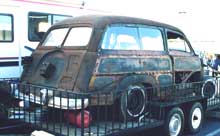Ford was America’s acknowledged wagonmaster, from the introduction of a woodie to the Model A catalog in 1929 (this is a ’30) right through the thirties and forties. In 1946, nearly 17,000 were built, more than all other manufacturers combined – including sibling Mercury. These were all upright four-door 8-passenger woodies; with all seats in place there was precious little cargo space. For all their varnished wood glamor, the woodies had one Achilles’ heel: if left to weather they would self destruct in no time.
With Ford’s radically-new 1949 models making their debut in June 1948, all that changed. Willys had introduced an all-steel wagon in 1946. A two-door on the Jeep chassis, it had vestigial “panels” stamped into the sheet metal as a strengthening measure, painted in the time-honored wood pattern. Plymouth took this one step farther for the “real” 1949 line, introduced that March (some holdover ‘48-style cars had been sold as “first series 1949s” because the new cars weren’t ready as the model year began). In the short-wheelbase P-17 Deluxe series was a two-door Suburban wagon, a six-seater with novel foldaway rear seat. The body was “All-Metal,” a harbinger of the future announcing that there wasn’t a hint of wood trim to be found.
For some reason, Ford decided to split the difference, to build a half-timbered wagon. The new Ford Station Wagon, in the Custom series, was also a two-door – with a moderately raked tail. The body was a mixture of wood and metal, with a single stamping for the roof, steel corners but side panels of mahogany plywood trimmed in maple. It had seating for eight and plenteous cargo space, though not without serious wrestling to remove the rear seats.
For 1950 the wagon was carried over, as was its Mercury stablemate. Introduced as the Custom Deluxe Station Wagon, it became the Country Squire in midyear and also gained a stamped steel tailgate. The Country Squire continued into 1951, by which time sales of the handy Plymouth Suburban had easily passed Ford’s wagons. In a catch-up attempt a fold-down second seat was added.
When Ford’s new lines for 1952 debuted, it was all over for real wood. All Chrysler cars had ditched it, and at GM Buick was the only holdout. (Pontiac and Chevrolet had hedged their bets in ’49, offering both a wood wagon and an all-steel version. Although wood sold better at first, by 1950 only the steel survived.) For ’52 Ford did a Plymouth and brought out the two-door Ranch Wagon, a six-passenger car with folding rear seat. But Ford had some aces in the hole, a companion four-door six-passenger Country Sedan and a new prestige Country Squire with seats for eight and a faux wood applique. Combined sales of ’52 Ford station wagons numbered 49,919 cleaned Plymouth’s clock and made Ford wagonmaster again. However, a dangerous precedent had been set, which eventually led to the use of fake wood on everything.
For truth in titling it must be noted that while Ford invoked an Olde English homonym in calling its two-door sedans “Tudor,” the designation was never applied to wagons, which were only ever called “two-door,” and seldom that.

